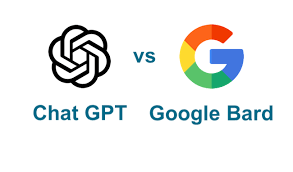ChatGPT vs Google Bard
In recent years, natural language processing (NLP) has become increasingly advanced, with language models such as ChatGPT and Google Bard leading the way in generating human-like text based on input prompts. These models have a wide range of applications, from chatbots to language translation and content creation. In this article, we’ll take a closer look at ChatGPT and Google Bard, how they work, and their strengths and weaknesses.
ChatGPT
ChatGPT is a language model that has been developed by OpenAI. It is based on the Generative Pre-trained Transformer (GPT) architecture, which is a type of deep learning model that has been trained on a massive amount of text data from the internet. The GPT architecture uses a technique called self-supervised learning, which means that it is trained on text data without any explicit labeling of the data. This allows the model to learn patterns and relationships in language data in an unsupervised manner, leading to a highly versatile and adaptable language model.
ChatGPT has been trained on a wide range of language data, including books, websites, and social media. This has allowed it to learn a wide range of language patterns and relationships, including syntax, semantics, and pragmatics. The model is available for public use through various APIs and platforms, such as OpenAI’s API, Hugging Face’s Transformers library, and Microsoft’s Azure Cognitive Services.
One of the key strengths of ChatGPT is its ability to generate coherent and engaging text based on user input. The model is able to understand and respond to a wide range of prompts, from simple questions to complex scenarios. This makes it ideal for use in chatbots, where it can provide personalized responses to users in a natural and engaging way.
Another strength of ChatGPT is its flexibility in understanding and responding to user prompts. The model is able to generate a wide range of responses based on the same input prompt, allowing it to provide diverse and creative output. This makes it ideal for use in content creation, where it can generate a wide range of articles, stories, and other forms of content based on user input.
However, there are also some limitations to ChatGPT. One of the main limitations is its tendency to generate biased or offensive language output. This is because the model is trained on language data from the internet, which can be biased or contain offensive content. As a result, it is important to carefully monitor and evaluate the language output generated by the model to ensure that it is appropriate for use in different contexts.
Google Bard
Google Bard is a language model that has been developed by Google. It is based on the Text-to-Text Transfer Transformer (T5) architecture, which is a more advanced architecture than the GPT architecture used by ChatGPT. The T5 architecture is a type of transformer model that has been trained on a wide range of natural language tasks, such as language translation, summarization, and question-answering. The T5 architecture uses a technique called transfer learning, which means that it is trained on a diverse set of tasks and data, allowing it to learn a wide range of language capabilities.
As of my knowledge cutoff date of September 2021, Google Bard was still in development and not yet publicly available. However, Google had released a demo of Google Bard, which allowed users to try out its capabilities. The demo showcased Google Bard’s impressive language capabilities, such as its ability to generate natural and coherent text, its ability to understand context and generate appropriate responses, and its ability to generate creative and original language output.
One of the key strengths of Google Bard is its ability to generate high-quality language output based on input prompts. The model is able to understand the context and generate responses that are appropriate for the given scenario. For example, if the input prompt is a question about a specific topic, Google Bard is able to generate a response that is accurate and informative. This makes it ideal for use in applications such as language translation, where it can generate accurate translations based on the input text.
Another strength of Google Bard is its ability to generate creative and original language output. The model is able to generate a wide range of responses based on the same input prompt, allowing it to provide diverse and engaging output. This makes it ideal for use in content creation, where it can generate unique and original articles, stories, and other forms of content based on user input.
However, like ChatGPT, Google Bard also has limitations. One of the main limitations is its computational requirements. The T5 architecture used by Google Bard is more advanced than the GPT architecture used by ChatGPT, which means that it requires more computational power to run. This can make it difficult to deploy the model in certain contexts, such as on mobile devices or in low-resource environments.
Another limitation of Google Bard is its lack of transparency. The model is highly complex, and it can be difficult to understand how it generates its language output. This can make it challenging to evaluate the accuracy and appropriateness of the language output generated by the model.
Overall, both ChatGPT and Google Bard are highly advanced language models that have the potential to revolutionize the field of natural language processing. While each model has its own strengths and limitations, they both demonstrate the power of deep learning and the potential for machines to understand and generate human-like language. As these models continue to develop and improve, we can expect to see even more advanced language capabilities that will enable us to communicate and interact with machines in increasingly natural and engaging ways.
(Note: This article is created using most of the inputs from ChatGPT.)

